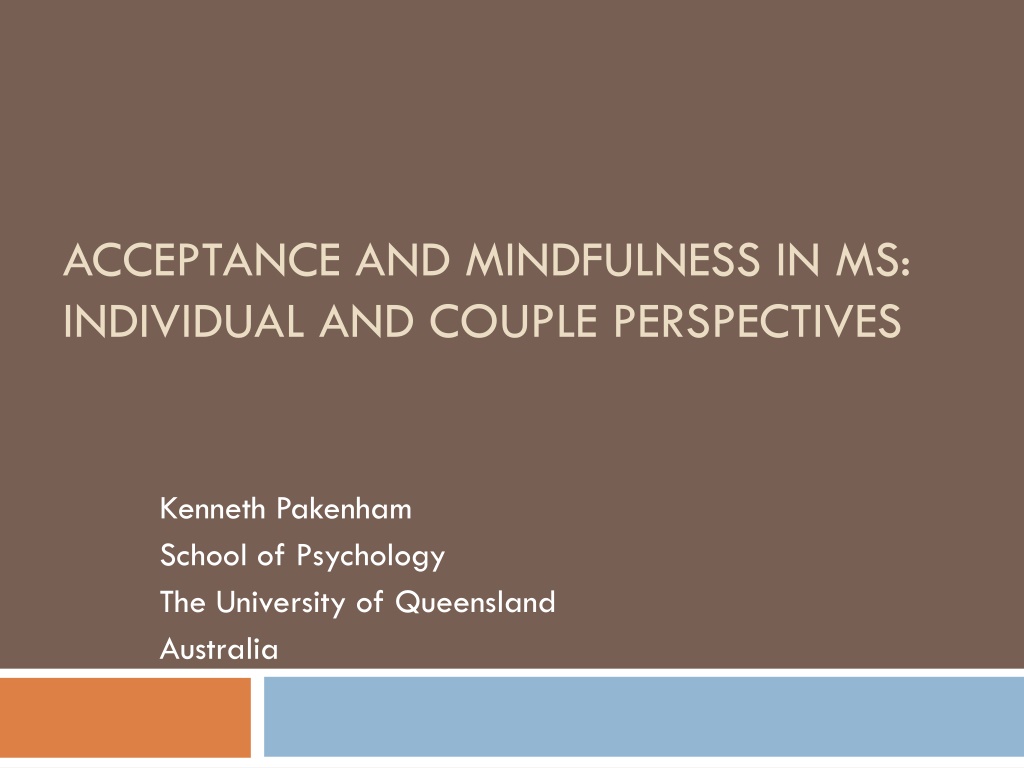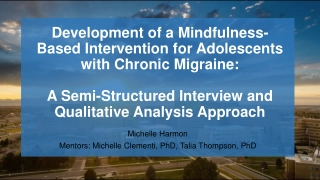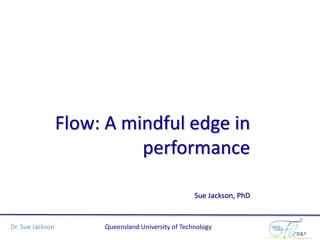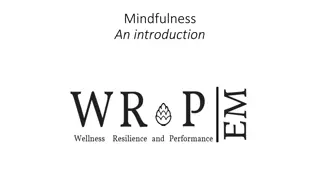Acceptance and Mindfulness in MS: Individual and Couple Perspectives Study
This study explores the roles of acceptance and mindfulness in adjusting to Multiple Sclerosis (MS) from individual and couple perspectives. It examines the impact of acceptance on various aspects of adjustment to MS, such as distress levels, positive affect, life satisfaction, marital adjustment, health, and more.
Download Presentation

Please find below an Image/Link to download the presentation.
The content on the website is provided AS IS for your information and personal use only. It may not be sold, licensed, or shared on other websites without obtaining consent from the author. Download presentation by click this link. If you encounter any issues during the download, it is possible that the publisher has removed the file from their server.
E N D
Presentation Transcript
ACCEPTANCE AND MINDFULNESS IN MS: INDIVIDUAL AND COUPLE PERSPECTIVES Kenneth Pakenham School of Psychology The University of Queensland Australia
Background: Characteristics of MS complex neurological disorder typically degenerative demyelination of nerve fibres interferes with transmission of impulses affects approximately 2.5 million persons worldwide (WHO, 2004) prevalence is twice as high in women as in men onset 20 - 40 the most common chronic neurological disease among young people no known cause or cure course is unpredictable clinical symptoms vary widely (eg. cognitive impairment, pain, fatigue, loss of bowel or bladder control, mobility impairments, and emotional changes) symptoms affect most, if not all, areas of a person s life 20% lifetime prevalence rate for depressive disorders 36% lifetime prevalence rate for anxiety disorders 28% of MS carers report clinically significant levels of distress
Background 2 studies investigate the roles of acceptance and mindfulness in adjusting to MS The MS context: radical acceptance present moment awareness that frequently involves experiencing the pain of decay
STUDY 1 (Pakenham & Flemming, 2012) Aim: to examine relations between acceptance and adjustment to MS using a purpose-built scale called the MS Acceptance Questionnaire (MSAQ). Hypothesis: acceptance would be associated with better adjustment to MS (lower distress & higher positive affect, life satisfaction & marital adjustment, & better health).
STUDY 1: method Data for Study 1 & 2 are drawn from longitudinal research on families coping with MS 128 parents with MS completed measures of demographics, illness & adjustment at Time 1, & measures of acceptance and adjustment 12 months later (Time 2). Mean age 43 years (SD = 6.5, range = 30 to 57) 84% female Mean illness duration 7.67 years (SD = 5.75, range = 4 months - 30 yrs) MS severity: 32% mild, 56% moderate, 10% severe
STUDY 1: method Adjustment Measures; completed at Time 1 & Time 2: Health status (Pakenham et al, 1994) Life satisfaction (Pavot & Diener, 1993) Positive affect (Bradburn, 1969) (Pakenham & Cox, 2008) Distress (Depression Anxiety &Stress Scale; Lovibond & Lovibond, 1995) Relationship satisfaction (Abbreviated Spanier Dyadic Adjustment Scale; Sharpley & Rogers, 1984)
STUDY 1: method Acceptance & Action Questionnaire (AAQ): 16-item AAQ (Bond & Bunce, 2003) 2 subscales: Action and Willingness MS Acceptance Questionnaire (MSAQ): Developed with reference to the AAQ & the CPAQ (McCracken, 1998) Items were adapted to reflect the experience of living with MS 20 (out of 25) items were endorsed by an expert panel and these constituted the MSAQ 7-point rating scale (1 = never true to 7 = always true) higher scores indicating greater acceptance of MS
STUDY 1: Factor analysis of the MSAQ Principal Components analysis (orthogonal & oblique rotations): Two factors, 51% of the total variance Action (8 items) 30% Willingness (8 items) 22% All items loaded >.50 Internal reliabilities: .87 Action; .79 Willingness Correlation .25, p<.01 Convergent validity: MSAQ Action: AAQ Action (r = .60, p<.01) AAQ Willingness (r = .44, p<.01) Acceptance coping (r = .58, p<.01) Acceptance sense making (r = .62, p<.01) MSAQ Willingness Acceptance coping (r = .19, p<.05)
STUDY 1: relations between MSAQ & illness, demographics & adjustment Less disability (r=.24, p<.01) & cognitive impairment (r=-.27, p<.01) related to higher MSAQ Action. Being in a relationship (F=3.94, p<.01) & being female (F=4.41, p=.04) were related to higher MSAQ Action. After controlling for the effects of initial adjustment & relevant demographic & illness variables (6 covariates): MSAQ Action predicted greater positive affect(12%), & health(5%) & marginal predictor of life satisfaction (2%). MSAQ Willingness predicted better health but lower positive affect AAQ (Action) predicted lower distress MSAQ 4 12% vs. AAQ 4%
STUDY 1: conclusions Findings support the beneficial effects of acceptance in MS Although acceptance declined as the disease progressed 2 MSAQ factors (Action & Willingness) reflect the dual definition of acceptance consistent with other ACT acceptance measures Sound psychometric properties MSAQ was a stronger predictor of adjustment to MS than the AAQ.
STUDY 1: conclusions Mixed findings re MSAQ Willingness: Reflect the ambiguous and complex nature of willingness EG. willingness to relinquish control of emotional reactions to illness may have health benefits by dampening emotional reactivity to illness, including the experience of positive emotions. Illness acceptance was related to less reliance on coping strategies focused on dealing with the emotional consequences of illness (Karademas & Hondronikola, 2010). Willingness subscale of the Tinnitus Acceptance Q aire was unrelated to adjustment in people with tinnitus (Westin et al, 2008). Measurement weaknesses: MSAQ Willingness items may tap passive resignation rather than active acceptance. Acceptance may be equated with approval
STUDY 2: (Pakenham & Samios, In press) To investigate the roles of mindfulness & acceptance on adjustment in couples coping with MS by examining: the effects of an individual s mindfulness & acceptance on their own adjustment (actor effects) and the effects of their partner s mindfulness & acceptance on their adjustment (partner effects) using the Actor-Partner Interdependence Model (Kenny, Kashy& Cook, 2006)
STUDY 2: hypotheses Actor effects: mindfulness & acceptance would be associated with better adjustment Partner effects: mindfulness & acceptance in each partner would be associated with better adjustment in the other partner Moderating effects: the partner effect of mindfulness would moderate the actor effect of mindfulness on adjustment the partner effect of acceptance would moderate the actor effect of acceptance on adjustment. Explored the moderating effects of gender & MS status (patient vs. spouse) on the actor and partner effects of mindfulness & acceptance on adjustment.
STUDY 2: method 69 couples completed Time 1 & Time 2 measures of mindfulness, acceptance & adjustment Dyadic data analytic approach (Kenny, Kashy& Cook, 2006) Terminology: participants are patients or spouses partner refers to the other person in the couple Patients: mean age 42 years; 78% female Spouses: mean age 43 years; 78% male mean duration of caregiving 5.91 years (SD = 4.68; range 1 month to 25 years)
STUDY 2: method Acceptance and Mindfulness Time 2 Acceptance: AAQ (Bond & Bunce, 2003) Mindfulness: Mindful Attention Awareness Scale (Brown & Ryan, 2003) Adjustment measures Times 1 & Time 2: Depression & Anxiety (DASS-21;Lovibond & Lovibond, 1995) Life satisfaction Positive affect Relationship satisfaction
STUDY 2: results Actor effects mindfulness & acceptance were associated with better adjustment, although beneficial actor effects of acceptance were evident across all adjustment domains (all Bs p<.01) whereas beneficial direct effects of mindfulness were only evident on distress (all Bs p<.01) Partner effects support for the beneficial impacts of partner acceptance on actor relationship satisfaction (B=.13,p<.01) ie. Individuals perceived better relationship satisfaction when their partner reported greater acceptance. Partner effects for mindfulness were not evident. (B = unstandardised coefficient)
STUDY 2: results Actor-Partner Interactions: Actor-partner interaction effect on depression (B=.01, p<.05) when the actor reported high acceptance & the partner reported low acceptance, the actor reported lower depression, whereas when both actor & partner reported high acceptance actors reported higher depression. Moderating effects of gender & MS status: No gender moderating effects MS status (patient vs. spouse) moderated: Link between mindfulness & relationship satisfaction (B=.08, p<.05) mindfulness was related to greater relationship satisfaction for patients, but was unrelated to relationship satisfaction for spouses. Link between acceptance & relationship satisfaction (B=.09, p<.05) Acceptance was related to greater relationship satisfaction for spouses, but was unrelated to relationship satisfaction for patients
Study 2: conclusions Mindfulness Beneficial actor effects of mindfulness on distress Absence of any direct effects on positive outcomes Similar to prior findings (Brown & Ryan, 2003) Dispositional vs. state mindfulness Beneficial effects of mindfulness on relationship satisfaction for patients, but not for spouses Increased mindfulness evident in patient benefit finding (Pakenham & Cox, 2009)
Study 2: conclusions Acceptance Beneficial effects of acceptance on all adjustment outcomes Beneficial effects of acceptance on relationship satisfaction for spouses, but not for patients caregiving entails many relationship challenges that require acceptance (Pakenham, 2008) Greater acceptance protects individuals from depression when in the context of lower partner acceptance. Complementary coping is related to marital adjustment in couples coping with chronic illness (Badr, 2004). High values-driven action in each partner may pull them in different life directions and create existential dilemmas in illness context need for couples to recalibrate values.

 undefined
undefined





























